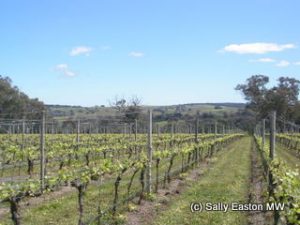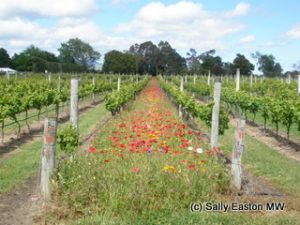Deliberating the nature of viticulture

Castagna Vineyard, Beechworth, Victoria, Australia
Sense of place and certification issues came into focus during a May 2012 Circle of Wine Writers panel discussion on organic, biodynamic and natural [my italics] viticulture.
Industry is still getting to grips with the various types of viticulture which have added varying degrees of sustainability value, such as organic and biodynamic. Unsurprisingly, in this forum, ‘conventional’ viticulture came in for some stick. John Bojanowski of Clos du Gravillas in the Languedoc asked why people chemically weed-kill, something that’s been going on for 50 to 60 years, since agrochemicals were developed. He said “there’s a constant drive to reduce the cost of everything we eat and drink” before adding that “conventional viticulture is now known as chemical viticulture.”
Certainly viticulture became a mono-cultural activity, and this limitation is partially addressed by alternative viticultures. Panel chair Dr. Jamie Goode noted non-conventional “vineyards are now seen as agro-ecosytems, with the vine as one player in a [broader] system that encompasses microbial life and cover crops.”
Improving the microbial life of soil was seen as pretty much essential by all the panellists. Tom Lubbe of Domaine Matassa, in the Roussillon said “it starts with respect for soil life. In vineyards worked chemically, with synthetic, systemic molecules, your soil life is largely destroyed.”
The weight and activity of tractors compounds the problem. Lubbe said “whether one is organic or biodynamic one has to have a vision of soil life. It’s easy to say ‘I’m biodynamic. I put on preparations then I plough seven times a year to make sure I have no weeds’, but bare earth is a crime. Most of your soil life activity takes place in the top few centimetres. If you do plough it’s a serious undertaking, it shouldn’t be too wet, dry, cold or hot. Ploughing is not necessary for healthy soil life.”
Didier Barral said something similar during my visit earlier this year.

Colourful cover crops
Talk of soil inevitably moved to terroir and expression of place. Julian Castagna of Castagna in Victoria, Australia said “for me, biodynamics is a way of farming that allows the land to speak of the land. It is trying to keep the land within itself, so you bring little or no influence of the outside world into the vineyards. If you get that right, then what you get in the produce of the land is authenticity.” However, he added “sometimes it’s great, sometimes it’s not so great.” I guess a choice of poor land is not a good formula, and there’s a need to match the selection of grape varieties to the patch of land, an idea well established in Europe and one beginning to gain traction in Australia.
Definitions could not be avoided in this discussion, and there was an admirable majority view that, despite their failings, certificated viticultural systems offer consumers some sort of tangible signposting.
Added to which there was general disapprobation of producers who suggest they use ‘biodynamic practices’ without certification, or producers who say “we’re almost organic’, but also maybe use a little synthetic weed killer or fertilise the vineyards. Clearly the terms are aspirational when some producers want to use the terms without paying the dues and doing the hard yards in the vineyard.
Consulting winemaker Ryan Carter said “the reality of running a wine business is more complicated than can be communicated easily. There is a basic truth in how little time you have to communicate your story to consumers. You need to ring a catchphrase. Natural, organic, biodynamic might still be in contention, meaning different things in different contexts. But organic and biodynamic are legally privileged terms. They are critical to capture the consumer in the small window of time you have to communicate to them.”
Bojanowski shared a different benefit of certification, saying “going through the certification process was a way to put down all our actions. There were things we hadn’t thought of, so we had to go back, and learn how to do things without outside crutches.”
Castagna has recently certified after years of biodynamic philosophy. He said “from the consumer point of view it became clear that we were falling behind, even though we were probably the first people [in Australia] to do biodynamics seriously, as a way of creating a wine of place. So I certified, though I don’t find it satisfactory.”
Lubbe agreed that “there is a value to certification. I work with Ecocert and it’s not perfect. It costs me €400 a year to be certified. It’s a lot of paperwork, but it’s not that big a hassle.”
Whether to announce certification on the wine label, or just to have the proof for those who ask, is another question entirely. Lubbe said “I don’t put AB [the organic logo] on Matassa production, the people who sell them are cavistes and sommeliers” who know the story and the people of its tiny production. But, Lubbe does use the AB logo on a batch of bigger production wine with broader distribution, saying “the AB mark has been appreciated by our customers. It gives them something to hang on to.”
Time to talk to customers comes out as vital in conveying the organic and biodynamic messages. Having the certificates to back up the talk clearly separates talkers from doers. Burgundy’s Joseph Drouhin is another producer who certified for this reason after years of practising organically.
Comments
4 Responses to “Deliberating the nature of viticulture”




August 3, 2012 at 9:36 am
Hi Sally
Interesting article and nice to see the plug for sustainability. However, here in the Loire we’re a little wary of the ‘labels’ and prefer growers to use their brains when it comes to looking after the vineyards.
Sometimes organic is great, but sometimes the bio products are not upto it, so growers should not be tied to only using specified products.
Personally, I prefer lutte raisonnée – and growers who are refuse to take on a certification.
One example : one organic grower in Vouvray tells me he’s had to spray 17 times so far this year. Meanwhile, a ‘raisonnée’ producer is getting ready to spray a 10th time.
This year, I’d say that ‘organic’ is not ‘sustainable’.
🙂
Always nice to have a little controversy!
Keep up the good work,
Charles
August 5, 2012 at 10:31 am
Hi Charles. I agree it is a dilemma. And this year is a case in point. But is this one year in ten? I still reckon boundaries/definitions are useful when trying to communicate the issues around different philosophies and realities. Things you bump up against which force you to make a decision one way or the other. Lutte raisonnée is almost impossible to define (not certified?), and open to so much abuse (bit like ‘natural’??).
August 5, 2012 at 4:35 pm
Here in the Loire, it’s not one year in ten it’s more like 4 or 5 a decade. And even one year of no wine or rotten wine is too many.
This is marginal climate, which is bril for making finely balanced wines, but only if you do it right. Rot, mildew and oidium are bad news.
I don’t believe the guys can make a living if they stick 100% to the organic rules, unless they price themselves out of the market, which defeats the object of making wine in the first place : feeding your family!
The whole point about ‘lutte raisonnée’ is the raisonnée bit – means they have to use their brains. Hence a personal preference for working with growers who are NOT certified – means they don’t stick to a list. That said, I only work with producers I know and trust…
The basics are simple : survey each plot regularly, treat when and where necessary, with an eye to the weather to enable the use of ‘microdoses’, and use the most effective and least damaging treatment possible. Better still is a reasoned vineyard management which limits the need for spraying in the first place, but that desn’t come cheap – and is way beyond the purse of the average UK customer, whose £4.88/bottle comes out at around 0.85€ per bottle ex-cellars.
I’ll say again : in a year like this, organic isn’t sustainable.
August 6, 2012 at 3:39 pm
You’re right of course. I reckon 2012 will go down as one of the most difficult for some time for cool marginal climates (slight understatement?). The UK was holding its breath for a while during a protracted flowering season. Gone a bit quiet now – I think we’ve had more sun than rain (though it doesn’t feel like it) in the last few weeks.
And there does have to be an economic side of the argument – feeding one’s family is important!
Then there is the ‘sustainability’ cost of those 7 extra, presumably tractor (compaction, or more likely churning up of wet soil, plus fuel) passages through the vineyard by a certified organic producer versus a ‘raisonnée’ guy.
But maybe you touch on a truly important issue – you’re working with guys you know and trust. You can have that conversation with your customers but I’m not convinced that the conversation filters much further, in a meaningful and comprehensible way, to consumers. At the end of the purchasing chain, consumers tend to have to rely on very short messages that take mere seconds to communicate. Or be highly wine-involved and able to ask the questions for themselves.
I’m certainly not doubting what you say about organic not being sustainable this year in the Loire.